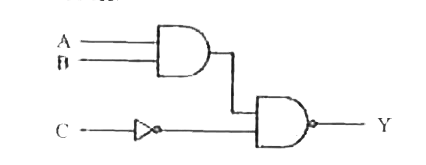Two particles of equal mass have velocities→V1=4ˆims−1 and →V2=4ˆjms−1 First particle has an acceleration →a1=(5ˆi+5ˆˆj)ms−1while the acceleration of the other particle is zero. The centre of mass of the two particles moves in a path of Solution in Telugu
Straight line
Parabola
Circle
Ellipse
The correct Answer is:(a)
→v1=4ˆim/s,a1=(5ˆj+5ˆj)m/s2
→v2=4ˆim/s,a2=0
vcm=m1→v1+m2→v2m1+m2=m(4ˆi)+(4ˆj)m+n=4ˆi+4ˆj2
acm=m1→a1+m2→a2m1+m2=m(5ˆi+5ˆj)+m(0)m+n=→a2
Therefore, the path of centre of mass will be a straight line.
Topper's Solved these Questions
Similar Questions
In the following circuit the output Y becomes zero for the input combinations

View SolutionThe specific heat of helium at constant volume is 12.6Jmol−1K−1. The specific heat of helium at constant pressure in Jmol−1K−1 is about
(Assume the temperature of the gas is moderate, universal gas constant, R=8.314Jmol−1K−1
View SolutionTwo particles of equal mass have velocities →v1=2ˆi=m/s−1 and →v2=2ˆjm/s−1. First particle has an acceleration →a1=(3ˆi+3ˆj)ms−2 while the acceleration of the other particle is zero. The centre of mass of the two particles moves in a path of.
View SolutionTwo particles of equal mass have velocities 2ˆims−1 and 2ˆjms−1. First particle has an acceleration (ˆi+ˆj)ms−2 while the acceleration of the second particle is zero. The centre of mass of the two particles moves in ?
View SolutionTwo particles of equal mass have velocities and . First particle has an acceleration while the acceleration of the other particle is zero. The centre of mass of the two particles moves in a path of
View SolutionTwo particle of equal mass have velocities →v1=2ˆi m/s and →v2=2ˆj m/s. First particle has an accelration →a1=(3ˆi+3ˆj)m/s2 while the acceleration of the other particle is zero. The centre of mass of the two particle moved on a
View SolutionTwo particles of equal masses have velocities vec(v)_(1)= 4hat(i) and vec(v)_(2) = 4 hat(j) . First particle hac an acceleration of the other particle is zero . The centre of mass of the two particles moves in a path of
View Solutionबराबर द्रव्यमानों के दो कणों के वेग →v1=2ˆi मी / सेकण्ड"तथा →v2=2ˆj मी / "सेकण्ड" हैं। पहले कण का त्वरण →a1=(3ˆi+3ˆj)मी/ सेकण्ड है जबकि अन्य कण का त्वरण शून्य है। दोनों कणों का द्रव्यमान केन्द्र किस मार्ग (Path) में गति करता है?
View SolutionTwo particles of equal mass have velocities→V1=4ˆims−1 and →V2=4ˆjms−1 First particle has an acceleration →a1=(5ˆi+5ˆˆj)ms−1while the acceleration of the other particle is zero. The centre of mass of the two particles moves in a path of
View SolutionTwo particles of equal mass have velocities→V1=4ˆims−1 and →V2=4ˆjms−1 First particle has an acceleration →a1=(5ˆi+5ˆˆj)ms−1while the acceleration of the other particle is zero. The centre of mass of the two particles moves in a path of
View SolutionTwo particles of equal mass have velocities v1=2ims−1 and v2=2jms−1 First particle has an acceleration a=(3i+3j)ms−2 while the acceleration of the other particle is zero. The centre of mass of the two particles moves in a path of
View SolutionA particle moves along straight line for 10 second with unifrom acceleration, a=2ms−2 . Then for next 10 second moves with acceleration, a=4ms−1. The total displacement of particle would be (initial velocity of particle is zero)
View SolutionTwo particles of equal mass have velocities →v1=2ˆi=m/s−1 and →v2=2ˆjm/s−1. First particle has an acceleration →a1=(3ˆi+3ˆj)ms−2 while the acceleration of the other particle is zero. The centre of mass of the two particles moves in a path of.
View Solutionएक कण सरल रेखा में समय t पर ams−2 के त्वरण से गतिमान है। जहाँ a=−1t2 है| t = 1s पर कण का वेग 3ms−1 है तो t = 4s पर कण का वेग ज्ञात करो।
View SolutionTwo particles of equal mass have velocities vec v_1 = 2 hat i= m//s^-1 and vec v_2 = 2hat j m//s^-1 . First particle has an acceleration vec a_1= (3 hat i+ 3 hat j) ms^-2 while the acceleration of the other particle is zero. The centre of mass of the two particles moves in a path of.
View Solution
